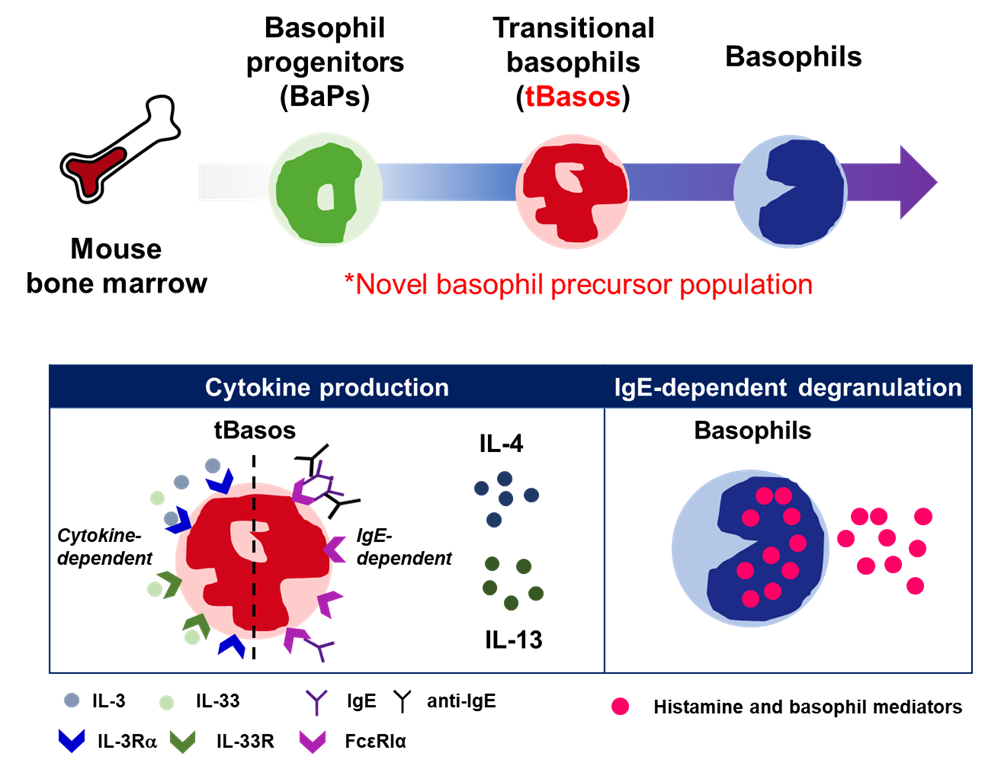| [Biological Sciences]Discovery of basophil-committed precursors sheds light on NFIL3’s role in basophil development | ||
|
||
|
The research team, led by Professor Suk-Jo Kang in the Department of Biological Sciences at KAIST, thoroughly explored the intricate developmental stages of basophils, the least common granulocytes but key players in allergic disorders. They identified transitional basophils (tBasos) as a unique late-stage precursor cell type descended from basophil progenitors (BaPs). These tBasos displayed exceptional cytokine secretion abilities but lagged in degranulation compared to mature basophils. The study identified a developmentally regulated transcription factor NFIL3/E4BP4 and revealed that NFIL3 is crucial for IgE-receptor-mediated cytokine secretion and degranulation. Additionally, using an atopic dermatitis mouse model, they demonstrated that NFIL3 modulates inflammatory responses by promoting cytokine production from basophils. In summary, the findings highlight NFIL3’s role in IgE-receptor-mediated signaling in basophils, pointing to NFIL3 and its target genes as potential therapeutic targets for type 2 cytokine-mediated allergies and disorders caused by basophils.
A recent study led by researchers from KAIST has revealed a new basophil precursor population and elucidated the role of the transcription factor NFIL3/E4BP4 in acquiring developmental stage-specific basophil function. The findings, published online in the Journal of Allergy and Clinical Immunology, unveiled the previously undefined terminal maturation process of basophil development and how the basophils establish their genuine identity during the developmental process. Basophils are the least abundant granulocytes; they play a regulatory role in various diseases such as allergic disorders and cancers. Their development occurs in bone marrow, where hematopoietic stem cells (HSCs) progress into common monocyte progenitors (CMPs), granulocyte monocyte progenitors (GMPs), and basophil/mast cell progenitors (BMCPs), or pro-basophil and mast cell progenitors (pro-BMPs) then pre-BMPs. This developmental pathway bifurcates into basophil progenitors (BaPs) and mast cell progenitors (MCPs). BaPs are known as unipotent basophil progenitor populations that give rise to mature basophils in the bone marrow, but the detailed terminal maturation process and the acquisition of basophil function have remained unclear. Professor Suk-Jo Kang’s team discovered a previously uncharacterized basophil-committed precursor cell type that originates from BaPs, termed transitional basophils (tBasos). The researchers demonstrated the distinct phenotypic and functional properties of tBasos from mature basophils, including high proliferative ability and remarkable capacity for cytokine-induced cytokine secretion with a dichotomous feature. Their analysis of gene expression during basophil development revealed how basophils acquire genuine functionality and establish basophil lineage. With the observation of a gradual increase in NFIL3 expression during basophil development, the researchers investigated the role of NFIL3 in basophil function and demonstrated that NFIL3 regulates IgE receptor-mediated cytokine secretion and degranulation, the bona-fide basophil functions, by modulating downstream calcium signaling. They provided evidence that NFIL3 modulates the inflammatory response in the oxazolone-induced atopic dermatitis (OX-AD) mouse model by promoting the production of IL-4 in basophils. Their research suggests that NFIL3 and its target genes could serve as potential therapeutic targets in basophil-mediated diseases, such as basophilia and allergic diseases mediated by type 2 immune responses.
Diagram depicting stages of basophil development in bone marrow, along with unique functional characteristics of tBasos and basophils in response external stimuli.
Schematic diagram elucidating role of NFIL3 in bona fide basophil function. #Basophils #Precursors #Atopic dermatitis #NFIL3/E4BP4 Web address for full article : https://www.jacionline.org/article/S0091-6749(23)01210-1/fulltext Web address for full article : https://doi.org/10.1016/j.jaci.2023.09.029 the Name of Journal : Journal of Allergy and Clinical Immunology Laboratory web-address of the author : https://sites.google.com/site/mcikaist/ |
||
|





